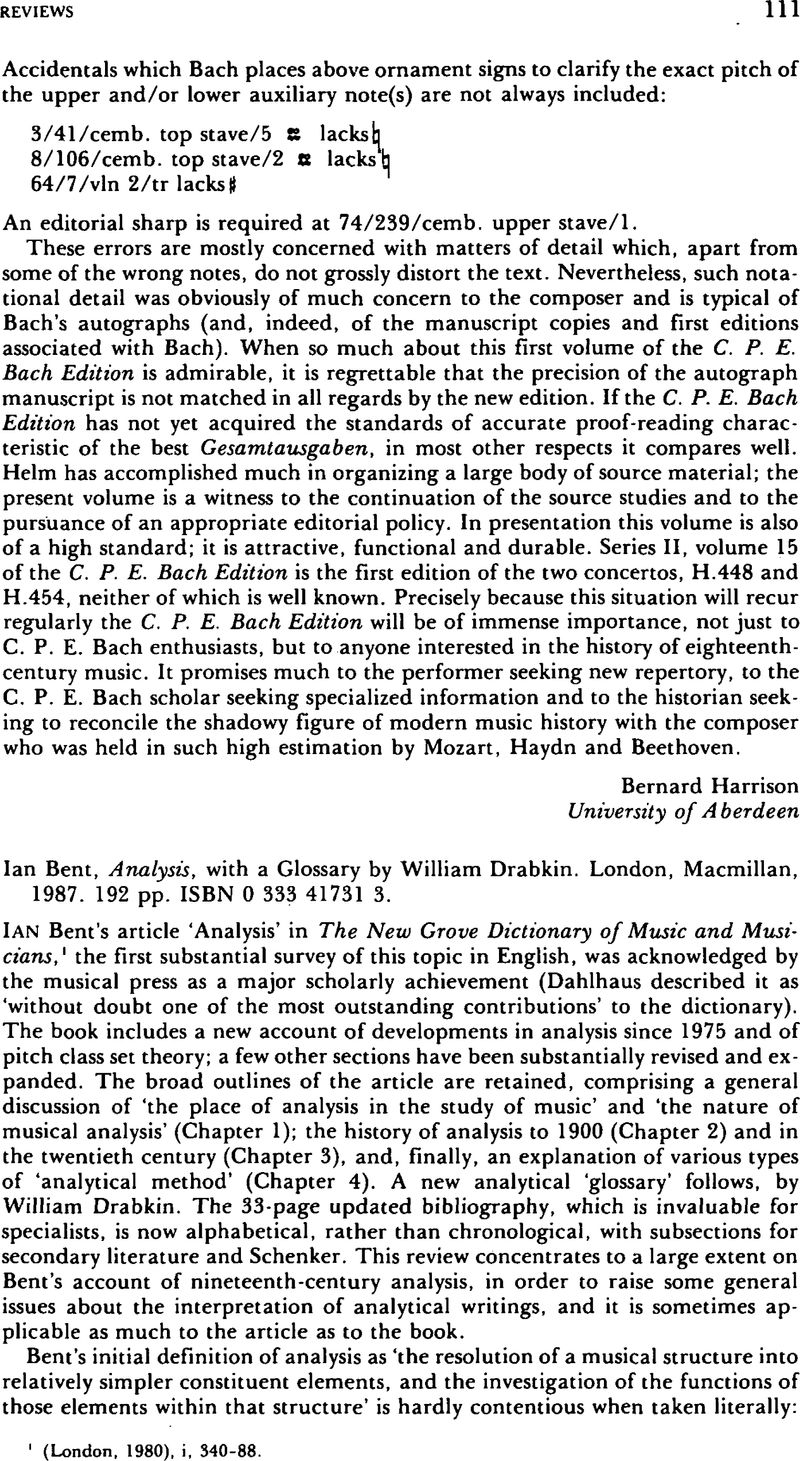No CrossRef data available.
Published online by Cambridge University Press: 01 January 2020

1 (London, 1980), i, 340–88.Google Scholar
2 The Musical Quarterly, 68 (1982), 163–5.Google Scholar
3 Leichtentritt, Hugo, Musical Form (rev. edn, Cambridge, Mass., 1951), Chapter 17.Google Scholar
4 The New Grove Dictionary, xviii, 758.Google Scholar
5 Music Analysis, 2 (1983), 105–7.Google Scholar
6 The New Grove Dictionary, viii, 181.Google Scholar
7 Koch, Heinrich Christoph, Introductory Essay on Composition: The Mechanical Rules of Melody, Sections 3 and 4, trans. Nancy Kovaleff Baker (New Haven, 1983), xxii. Baker, in a paper delivered at the Oxford University Music Analysis Conference 1988, concluded that, despite the clear parallels between the ideas of Reicha and Koch, Reicha was probably unfamiliar with Koch's Essay.Google Scholar
8 Moyer, Birgitte, ‘Concepts of Musical Form in the Nineteenth Century with Special Reference to A. B. Marx and Sonata Form’ (Ph.D. dissertation, Stanford University, 1969), 90–3.Google Scholar
9 For discussion of the publication date of this treatise, see Newman, William, Communication, Journal of the American Musicological Society, 20 (1967), 513–15; and his The Sonata Since Beethoven (3rd edn, New York, 1983), 29–31.Google Scholar
10 Czerny, Carl, School of Practical Composition, trans. John Bishop (London, ?1849), i, 93.Google Scholar
11 For further reference to reductive techniques of analysis in the nineteenth century, see Bent, Ian, ‘Analytical Thinking in the First Half of the Nineteenth Century’, Modern Musical Scholarship, ed. Edward Olleson (Stocksfield, 1980), 151–60; and Robert Morgan, ‘Schenker and the Theoretical Tradition’, College Music Symposium, 18 (1978), 72–96.Google Scholar
12 Reicha, Anton, Course of Musical Composition or Complete and Methodical Treatise of Practical Harmony [Cours de composition musicale], trans. (with the remarks of Carl Czerny translated from the German) Arnold Merrick, ed. John Bishop (London, 1854), 156.Google Scholar
13 All translations in this paragraph are from Reicha, op. cit., 349.Google Scholar
14 Hadow, W. H., Sonata Form (London, 1896), 13.Google Scholar
15 Goetschius, Percy, Lessons in Musical Form: A Manual of Analysis of All the Structural Factors and Designs Employed in Musical Compositions (Boston, 1904), 106.Google Scholar
16 Macpherson, Stewart, Form in Music (London, 1908; rev. 1930), 91.Google Scholar
17 Pauer, Ernst, Musical Forms (London, 1878), 37.Google Scholar
18 Prout, Ebenezer, Applied Forms (London, 1895), 1.Google Scholar
19 Schoenberg, Arnold, Fundamentals of Musical Composition, ed. Gerald Strang (London, 1970), 1 and 213.Google Scholar
20 Schenker, Heinrich, Free Composition: Volume III of New Musical Theories and Fantasies, trans. and ed. Ernst Oster (New York, 1979), xxi.Google Scholar
21 Riemann, Hugo, Handbuch der Fugen-Komposition, 3 vols. (3rd edn, Leipzig, 1914).Google Scholar
22 Marx, Adolph Bernhard, The Music of the Nineteenth Century and its Culture [Die Musik des neunzehnten fahrhunderts und ihre Pflege: Methode der Musik], trans. A. H. Wehran (London, 1855), 45.Google Scholar
23 Marx, General Musical Instruction (Allgemeine Musiklehre): An Aid to Teachers and Learners in Every Branch of Musical Knowledge, trans. George Macirone (London, 1854), 111.Google Scholar
24 Moyer, ‘Concepts of Musical Form’, 69.Google Scholar
25 Ibid., 127–8.Google Scholar
26 See, for example, Schenker, Harmonielehre, 131–2.Google Scholar
27 Ibid., xxi.Google Scholar
28 Forte, Allen, The Structure of Atonal Music (New Haven, 1973).Google Scholar
29 Ibid., 210.Google Scholar
30 Ibid., 93.Google Scholar